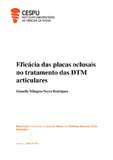| dc.contributor.advisor | COELHO, JOSÉ ALBERTO GONÇALVES DA ROCHA | |
| dc.contributor.author | Neyra Rodríguez, Gianella Milagros | |
| dc.date.accessioned | 2023-11-16T13:39:18Z | |
| dc.date.available | 2023-11-16T13:39:18Z | |
| dc.date.issued | 2023 | |
| dc.identifier.uri | http://hdl.handle.net/20.500.11816/4305 | |
| dc.description.abstract | Introdução: As disfunções temporomandibulares são um grupo de distúrbios dolorosos na região orofacial que envolvem a ATM e os músculos mastigatórios e ocorre quando não é possível manter em harmonia a ATM.
Objetivo: Investigar a eficácia das placas oclusais no tratamento das disfunções articulares.
Materiais e métodos: A pesquisa bibliográfica foi realizada no PubMed, PMC e Google Scholar usando as palavras-chaves. Os critérios de inclusão foram artigos publicados desde 2007 até 2022, que abordaram o tema do trabalho, os artigos foram filtrados e avaliados individualmente para atender aos objetivos do trabalho.
Resultados: Foram identificados 20 artigos; 9 artigos referiam-se a placa de estabilização, 2 artigos a placas em relação céntrica, 9 artigos referiam-se a placas moles, individualizadas, modificadas, Michigan ou digitais.
Discussão: Para o tratamento das disfunções articulares a placa mais efetiva foi de estabilização na redução da dor e aumento da abertura oral nos casos de deslocamento do disco com ou sem redução e artralgia. Não demonstrou muita eficácia na redução dos ruídos articulares.
Conclusão: Deve se ter em conta o diagnostico da disfunção articular, para utilizar a placa oclusal adequada no respetivo caso. Além disso, encontrou-se que em combinação com outras terapias, resolvem a sintomatologia mais rapidamente e com maior eficácia. | pt_PT |
| dc.description.abstract | Introduction: Temporomandibular joint disorders are a group of painful disorders in the orofacial region that involve the TMJ and the masticatory muscles and occur when it is not possible to keep the TMJ in harmony.
Objective: To investigate the effectiveness of the occlusal splint in the treatment of joint disorders
Material and methods: The literature search was performed in PubMed, PMC, Science Direct, and Google Scholar. Inclusion criteria were articles published from 2007 to 2022, which addressed the topic of the work, the articles were filtered and evaluated individually to meet the objective of the work.
Results: 20 articles were identified; 9 articles referred to stabilization splints, 2 articles to centric relation splints, and 9 articles referred to soft, individualized, modified, Michigan or digital splints.
Discussion: For the treatment of joint disorders, the most effective splint was the stabilization splint in reducing pain and increased mouth opening in cases of disc displacement with or without reduction and arthralgia. It has not shown much effectiveness in reducing joint sounds.
Conclusion: The diagnosis of joint dysfunction must be considered to use the appropriate occlusal splint in the respective case. Furthermore, it was found that combined with other therapies, they resolve the symptoms more quickly and effectively. | pt_PT |
| dc.language.iso | por | pt_PT |
| dc.rights | info:eu-repo/semantics/openAccess | pt_PT |
| dc.subject | Temporomandibular joint disorders | pt_PT |
| dc.subject | Occlusal splint | pt_PT |
| dc.subject | Treatment | pt_PT |
| dc.title | Eficácia das placas oclusais no tratamento das DTM articulares | pt_PT |
| dc.type | info:eu-repo/semantics/masterThesis | pt_PT |
| dc.identifier.tid | 203373499 | pt_PT |
| thesis.degree.name | Mestrado em Medicina Dentária | pt_PT |

